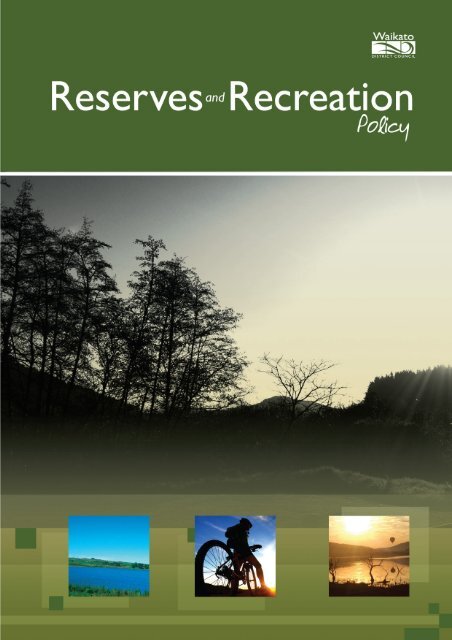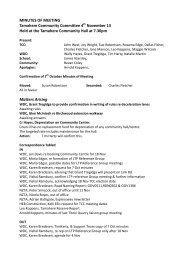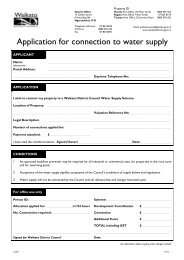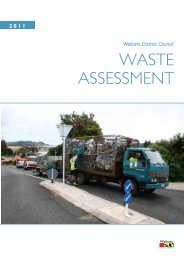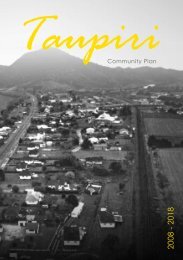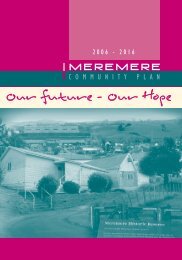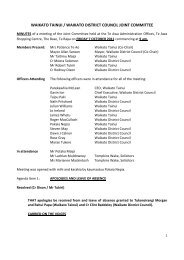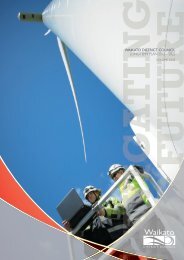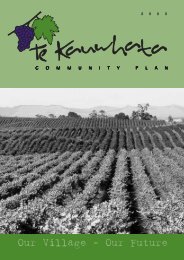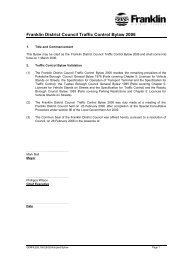Reserves and Recreation Policy - Waikato District Council
Reserves and Recreation Policy - Waikato District Council
Reserves and Recreation Policy - Waikato District Council
You also want an ePaper? Increase the reach of your titles
YUMPU automatically turns print PDFs into web optimized ePapers that Google loves.
CONTENTS<br />
SECTION 1 - INTRODUCTION.................................................................................................... 3<br />
1.1 Purpose ............................................................................................................................... 3<br />
1.2 Background......................................................................................................................... 3<br />
1.3 <strong>Recreation</strong>al activity ......................................................................................................... 4<br />
1.4 Population growth ............................................................................................................4<br />
SECTION 2 – POLICY CONTEXT................................................................................................ 5<br />
2.1 Legislative context ............................................................................................................ 6<br />
2.1.1 Local Government Act 2002 ..................................................................................... 6<br />
2.1.2 <strong>Reserves</strong> Act 1977 ....................................................................................................... 6<br />
2.1.3 Resource Management Act 1991.............................................................................. 7<br />
2.1.4 Historic Places Act 1993 ............................................................................................ 7<br />
2.2 National Strategies............................................................................................................ 8<br />
2.3 Regional Strategies............................................................................................................ 8<br />
2.4 <strong>Waikato</strong> <strong>District</strong> <strong>Council</strong> Planning Documents......................................................... 8<br />
2.4.1 <strong>Waikato</strong> <strong>District</strong> Growth Strategy........................................................................... 8<br />
2.4.2 Long-Term <strong>Council</strong> Community Plan...................................................................... 9<br />
2.4.3 Conservation Strategy................................................................................................. 9<br />
2.4.4 Walking <strong>and</strong> Cycling Strategy.................................................................................... 9<br />
2.4.5 Heritage <strong>Policy</strong>.............................................................................................................. 9<br />
2.4.6 Arts <strong>Policy</strong>.................................................................................................................... 10<br />
2.4.7 Annual Plan .................................................................................................................. 10<br />
2.4.8 Parks <strong>and</strong> <strong>Reserves</strong> Asset Management Plan ....................................................... 11<br />
2.5 Deed of Settlement for the <strong>Waikato</strong> River ..............................................................12<br />
SECTION 3 – OBJECTIVES & POLICIES .................................................................................... 13<br />
3.1 Objectives ........................................................................................................................... 13<br />
3.2 Policies.................................................................................................................................15<br />
SECTION 4 – FUTURE DEVELOPMENT................................................................................... 29<br />
4.1 Future reserve <strong>and</strong> recreation development .................................................................. 29<br />
4.2 Review......................................................................................................................................29<br />
2<br />
APPENDIX ONE: NATIONAL STRATEGIES RELATING TO RESERVES AND RECREATION……..….30<br />
APPENDIX TWO: REGIONAL STRATEGIES RELATING TO RESERVES AND RECREATION……...…31<br />
APPENDIX THREE: WAIKATO DISTRICT COUNCIL'S LEVELS OF SERVICE FOR RESERVES AND<br />
RECREATION RELATED RESOURCES WITHIN THE WAIKATO DISTRICT……...32
SECTION 1 - INTRODUCTION<br />
3<br />
1.1 Purpose<br />
The purpose of <strong>Waikato</strong> <strong>District</strong> <strong>Council</strong>'s <strong>Reserves</strong> <strong>and</strong> <strong>Recreation</strong> <strong>Policy</strong> is to identify<br />
<strong>Council</strong>s role in relation to reserves <strong>and</strong> recreation within the <strong>Waikato</strong> <strong>District</strong>, including<br />
the purchase, development <strong>and</strong> sale of reserves.<br />
The <strong>Reserves</strong> <strong>and</strong> <strong>Recreation</strong> <strong>Policy</strong> contains a description of the policy context, objectives<br />
<strong>and</strong> policies to help guide <strong>Council</strong> decision-making relating the provision of reserves <strong>and</strong><br />
recreation resources within the <strong>District</strong>, <strong>and</strong> information regarding how reserves <strong>and</strong><br />
recreation development will be included in <strong>Council</strong> planning frameworks.<br />
Future works relating to reserves <strong>and</strong> recreation will be incorporated into <strong>Waikato</strong> <strong>District</strong><br />
<strong>Council</strong>’s long-term <strong>and</strong> annual planning processes, <strong>and</strong> will align with the Parks <strong>and</strong><br />
<strong>Reserves</strong> Asset Management Plan. <strong>Waikato</strong> <strong>District</strong> <strong>Council</strong> aims to approach the task of<br />
providing resources in a consistent <strong>and</strong> systematic manner. Objectives <strong>and</strong> policies within<br />
this document should also align with other relevant documents, including national strategies<br />
<strong>and</strong> other <strong>Waikato</strong> <strong>District</strong> <strong>Council</strong> strategies <strong>and</strong> policies.<br />
1.2 Background<br />
<strong>Recreation</strong> is an important part of people’s lives, <strong>and</strong> has a very broad definition. For some<br />
it involves organised sports such as rugby, cricket, golf or netball. For some it involves<br />
informal activities such as surfing or walking, for others it involves music or crafts.<br />
<strong>Recreation</strong> results in a number of social benefits including improved physical <strong>and</strong> mental<br />
health, greater community cohesion through common activities <strong>and</strong> interests, <strong>and</strong> a sense of<br />
local or national pride <strong>and</strong> identity. <strong>Recreation</strong> facilities provide the opportunity for people<br />
to get together in an informal setting, <strong>and</strong> can also improve the appearance of an area (e.g.<br />
attractively l<strong>and</strong>scaped open areas). Economic benefits resulting from recreation are also<br />
significant. <strong>Recreation</strong> <strong>and</strong> tourism are multi-million dollar industries that support<br />
thous<strong>and</strong>s of jobs around the country.<br />
<strong>Council</strong> has an important role in providing reserves <strong>and</strong> facilities <strong>and</strong> in promoting<br />
recreation for at least three reasons. The first is the range of benefits stated above. The<br />
second is the <strong>Council</strong>’s responsibilities under the Local Government Act 2002 <strong>and</strong> the<br />
Resource Management Act 1991, including the provision of facilities, promoting community<br />
well-being <strong>and</strong> protecting significant environmental features. The third reason is that<br />
commercial ventures are market-driven <strong>and</strong> hence will not meet the needs of all residents<br />
<strong>and</strong> visitors; the <strong>Council</strong> has a role in addressing equity issues.
1.3 <strong>Recreation</strong>al activity<br />
4<br />
Within the <strong>Waikato</strong> <strong>District</strong>, there has been a particularly high dem<strong>and</strong> for walkway<br />
development in recent years. Water-based activities, such as boating on <strong>Waikato</strong> <strong>District</strong><br />
lakes, waka ama on the <strong>Waikato</strong> River, <strong>and</strong> surfing at Raglan’s coastal reserves, have<br />
remained very popular. Organised sports activities, while still popular, are slightly less so<br />
with some clubs having to work harder to maintain sufficient membership <strong>and</strong> volunteers.<br />
Some organised sports facilities are strategically located, for example Taupiri is a strategic<br />
base for Netball within the <strong>District</strong>. Community Halls are utilised for recreation activities,<br />
such as indoor bowling at Taupiri Soldiers <strong>and</strong> Settlers Hall, <strong>and</strong> karate classes at Raglan<br />
Town Hall. Hunting <strong>and</strong> Fishing occurs around some water bodies within the <strong>Waikato</strong><br />
<strong>District</strong>, for example duck hunting at Lake Kainui.<br />
Smaller centre residents, such as Glen Afton, Eureka, <strong>and</strong> Rangiriri residents, generally<br />
travel to larger centres, such as Ngaruawahia, Huntly, Te Kauwhata, <strong>and</strong> Hamilton, to<br />
participate in activities. Within these smaller centres, school recreation facilities are often<br />
an important community resource.<br />
Within <strong>Council</strong>-owned parks <strong>and</strong> reserves, <strong>Waikato</strong> <strong>District</strong> <strong>Council</strong> supplies a variety of<br />
recreation resources to local <strong>and</strong> regional communities; these include boat ramps,<br />
playgrounds, skate parks, courts, junior <strong>and</strong> senior sports fields, sports pavilions, <strong>and</strong> park<br />
furniture.<br />
1.4 Population growth<br />
As <strong>Waikato</strong> <strong>District</strong> communities grow there will be a need to develop reserves <strong>and</strong><br />
recreation resources to meet community needs. It is estimated that in fifty years the<br />
<strong>Waikato</strong> <strong>District</strong> population will have risen from 43,959 (2006 Census) to 88,000 residents,<br />
doubling the <strong>District</strong>’s population.<br />
<strong>Waikato</strong> <strong>District</strong> <strong>Council</strong> intends to provide neighbourhood parks <strong>and</strong> sports fields in new<br />
residential areas, <strong>and</strong> these will often include playgrounds <strong>and</strong> skate park facilities. New<br />
residents are also likely to utilise existing resources, <strong>and</strong> a higher level of service may<br />
needed to provide extra capacity at existing sites.
SECTION 2 – POLICY CONTEXT<br />
5<br />
There are several documents that affect how <strong>Waikato</strong> <strong>District</strong> <strong>Council</strong> approaches<br />
recreation provision within the <strong>District</strong>, <strong>and</strong> how <strong>Waikato</strong> <strong>District</strong> parks <strong>and</strong> reserves<br />
should be utilised <strong>and</strong> managed. These come in the form of legislation, such as the <strong>Reserves</strong><br />
Act 1977 <strong>and</strong> the Resource Management Act 1991; national strategies developed by central<br />
government, such as the National Walking <strong>and</strong> Cycling Strategy; <strong>and</strong> regional strategies,<br />
such as Future Proof - the sub-regional growth strategy currently being developed by<br />
<strong>Waikato</strong> <strong>District</strong> <strong>Council</strong>, Waipa <strong>District</strong> <strong>Council</strong>, Hamilton City <strong>Council</strong>, <strong>and</strong> Environment<br />
<strong>Waikato</strong>. Figure 1 identifies the hierarchy of documents <strong>and</strong> illustrates how these relate to<br />
each other.<br />
Figure 1: Hierarchy of documents relating to the <strong>Reserves</strong> <strong>and</strong> <strong>Recreation</strong> <strong>Policy</strong><br />
National Strategies, Policies,<br />
&<br />
Government Legislation<br />
e.g.<br />
<strong>Reserves</strong><br />
Act 1977<br />
Regional Strategies, Policies, Plans<br />
e.g.<br />
Future<br />
Proof<br />
WDC Strategies, Policies, Plans<br />
e.g.. <strong>Reserves</strong> <strong>and</strong><br />
<strong>Recreation</strong> <strong>Policy</strong>,<br />
WDC Asset Management Plan<br />
Walking <strong>and</strong> Cycling<br />
Strategy, Structure<br />
Plans, Community<br />
Plans<br />
WDC Long Term <strong>Council</strong><br />
Community Plan<br />
WDC Annual Plan
6<br />
2.1 Legislative context<br />
Several legislative documents apply to <strong>Waikato</strong> <strong>District</strong> <strong>Council</strong> parks <strong>and</strong> reserves. The<br />
more significant of these are detailed below.<br />
2.1.1 Local Government Act 2002<br />
The Local Government Act 2002 identifies the purpose <strong>and</strong> structure of local government<br />
authorities, local government authorities’ roles <strong>and</strong> obligations, <strong>and</strong> principles <strong>and</strong><br />
frameworks for how local authorities must operate (e.g. planning <strong>and</strong> decision-making<br />
frameworks).<br />
2.1.2 <strong>Reserves</strong> Act 1977<br />
The <strong>Reserves</strong> Act 1977 provides for the management <strong>and</strong> preservation of areas public l<strong>and</strong><br />
vested or gazetted under the Act for the benefit of the public. The Act also provides for<br />
the preservation of representative natural ecosystems or l<strong>and</strong>scapes <strong>and</strong> the survival of<br />
indigenous species of flora <strong>and</strong> fauna; preservation of public access to the coastline, isl<strong>and</strong>s,<br />
lakeshore <strong>and</strong> riverbanks, <strong>and</strong> encourages the protection <strong>and</strong> preservation of the natural<br />
character of these environments; to the maximum practicable extent.<br />
The <strong>Reserves</strong> Act 1977 also provides classifications for reserves vested under the Act. The<br />
classification of a reserve is dependant on its purpose.<br />
The <strong>Reserves</strong> Act 1977 requires that a reserve management plan be developed for any<br />
reserve vested in <strong>Waikato</strong> <strong>District</strong> <strong>Council</strong>:<br />
“The management plan shall provide for <strong>and</strong> ensure the use, enjoyment, maintenance, protection,<br />
<strong>and</strong> preservation, as the case may require, <strong>and</strong>, to the extent that the administering body's resources<br />
permit, the development, as appropriate, of the reserve for the purposes for which it is classified, <strong>and</strong><br />
shall incorporate <strong>and</strong> ensure compliance with the principles set out…for a reserve of that<br />
classification.”
In accordance with the <strong>Reserves</strong> Act 1977, reserve management plans should remain under<br />
continuous review.<br />
7<br />
2.1.3 Resource Management Act 1991<br />
The purpose of the Resource Management Act 1991 is to promote the sustainable<br />
management of natural <strong>and</strong> physical resources. The Resource Management Act 1991<br />
provides regulatory mechanisms that have an impact on type <strong>and</strong> effect of permitted<br />
behaviour within <strong>Council</strong> parks <strong>and</strong> reserves. <strong>Waikato</strong> <strong>District</strong> <strong>Council</strong>’s <strong>District</strong> Plan has<br />
been developed in accordance with the Resource Management Act 1991.<br />
2.1.4 Historic Places Act 1993<br />
The Historic Places Act 1993 promotes:<br />
“the identification, protection, preservation <strong>and</strong> conservation of the historic <strong>and</strong> cultural<br />
heritage of New Zeal<strong>and</strong>”.<br />
Within this act, an archaeological site is identified as a place where activity has taken place<br />
prior to 1900. The Historic Places Act applies to all archaeological sites, both those that<br />
have been recorded <strong>and</strong> also those that have not. Before any modification, damage, or<br />
destruction of any archaeological site an authority needs to be granted by the New Zeal<strong>and</strong><br />
Historic Places Trust. An authority should be requested from the New Zeal<strong>and</strong> Historic<br />
Places Trust, <strong>and</strong> is required if there is “reasonable cause” to believe that an archaeological<br />
site may be modified, damaged, or destroyed. The Historic Places Amendment Act 2004<br />
clarifies matters relating to the structure of the New Zeal<strong>and</strong> Historic Places Trust <strong>and</strong> its<br />
register, <strong>and</strong> also provides some technical amendments to the Historic Places Act 1993.
8<br />
2.2 National Strategies<br />
Central government has developed national strategies that <strong>Waikato</strong> <strong>District</strong> <strong>Council</strong> must<br />
align with when developing local district recreation related strategies. These include the<br />
National Walking <strong>and</strong> Cycling Strategy – Getting There – on foot, by cycle, <strong>and</strong> the National<br />
Disability Strategy. A summary of these documents can be found within Appendix One.<br />
2.3 Regional Strategies<br />
<strong>Waikato</strong> <strong>District</strong> <strong>Council</strong> is working with other <strong>Council</strong>s <strong>and</strong> local government bodies to<br />
produce regional strategies that relate to developing recreational capacity within the<br />
<strong>Waikato</strong> Region. Future Proof – Knowing our future by planning today is a sub-regional<br />
growth strategy being developed by Hamilton City <strong>Council</strong>, Waipa <strong>District</strong> <strong>Council</strong>,<br />
<strong>Waikato</strong> <strong>District</strong> <strong>Council</strong>, <strong>and</strong> Environment <strong>Waikato</strong>. Environment <strong>Waikato</strong> is also<br />
developing a regional walking <strong>and</strong> cycling strategy that will influence the future of walking<br />
<strong>and</strong> cycling in the region. Further detail on these documents can be found in Appendix<br />
Two.<br />
2.4 <strong>Waikato</strong> <strong>District</strong> <strong>Council</strong> Planning Documents<br />
Several <strong>Waikato</strong> <strong>District</strong> <strong>Council</strong> strategies <strong>and</strong> policies influence the development of<br />
reserve <strong>and</strong> recreation resources within the <strong>District</strong>, <strong>and</strong> are identified below:<br />
2.4.1 <strong>Waikato</strong> <strong>District</strong> Growth Strategy<br />
<strong>Waikato</strong> <strong>District</strong> <strong>Council</strong> has developed a <strong>Waikato</strong> <strong>District</strong> Growth Strategy, which seeks<br />
to manage future growth within the <strong>District</strong>. This strategy will influence the location <strong>and</strong><br />
nature of future growth, which will in turn influence the level <strong>and</strong> location of recreational<br />
resources within the <strong>District</strong>.
9<br />
2.4.2 Long-Term <strong>Council</strong> Community Plan<br />
The <strong>Waikato</strong> <strong>District</strong> Long Term <strong>Council</strong> Community Plan (LTCCP) is a long-term<br />
community-planning document that provides a road map for the future direction of the<br />
<strong>Waikato</strong> <strong>District</strong>. It is a ten-year plan <strong>and</strong> is reviewed every three years. The LTCCP<br />
identifies <strong>Council</strong>’s overall budget, which is decided upon through consideration of all<br />
<strong>Council</strong>’s functions. Funding decisions relating to <strong>Waikato</strong> <strong>District</strong> <strong>Council</strong> Parks <strong>and</strong><br />
<strong>Reserves</strong> will be made within this broader context.<br />
2.4.3 Conservation Strategy<br />
<strong>Waikato</strong> <strong>District</strong> <strong>Council</strong>’s Conservation Strategy defines how <strong>Waikato</strong> <strong>District</strong> <strong>Council</strong> will<br />
work towards managing its obligations regarding biodiversity as specified within the<br />
Resource Management Act 1991 <strong>and</strong> the New Zeal<strong>and</strong> Biodiversity Strategy (2000). The<br />
strategy provides implementation methods to meet its responsibilities within these<br />
documents. The strategy also aligns with <strong>Council</strong>’s <strong>District</strong> Plan <strong>and</strong> long-term planning<br />
framework.<br />
2.4.4 Walking <strong>and</strong> Cycling Strategy<br />
The purpose of <strong>Waikato</strong> <strong>District</strong> <strong>Council</strong>’s Walking <strong>and</strong> Cycling Strategy is to improve the<br />
viability of walking <strong>and</strong> cycling as modes of transport, <strong>and</strong> to promote the health benefits of<br />
walking <strong>and</strong> cycling. The strategy also seeks to reduce the negative environmental impact<br />
when motor vehicles are utilised for short trips, reducing air pollution <strong>and</strong> traffic<br />
congestion. Objectives, actions, <strong>and</strong> projects relating to walking <strong>and</strong> cycling will be reflected<br />
within this document.<br />
2.4.5 Heritage <strong>Policy</strong><br />
<strong>Waikato</strong> <strong>District</strong> <strong>Council</strong>’s Heritage <strong>Policy</strong> provides for the protection of heritage sites <strong>and</strong><br />
consideration of heritage needs within the <strong>Waikato</strong> <strong>District</strong>. Policies relate to regulatory<br />
measures, advocacy <strong>and</strong> promotion initiatives, <strong>and</strong> the provision of financial assistance,<br />
relating to heritage-related projects <strong>and</strong> activities.
10<br />
The heritage policy relates to parks <strong>and</strong> reserves through activities undertaken to preserve<br />
natural <strong>and</strong> cultural heritage on <strong>Council</strong>-owned parks <strong>and</strong> reserves, the development of<br />
facilities emphasising culture <strong>and</strong> heritage, <strong>and</strong> activities undertaken to preserve history <strong>and</strong><br />
knowledge of the <strong>Waikato</strong> <strong>District</strong>. Key projects within the heritage policy include <strong>Council</strong><br />
consideration concerning the acquisition of additional historic reserves, working with<br />
external groups aimed at developing heritage facilities, <strong>and</strong> recognising <strong>and</strong> presenting<br />
information on heritage (e.g. museums <strong>and</strong> heritage trails).<br />
2.4.6 Arts <strong>Policy</strong><br />
<strong>Waikato</strong> <strong>District</strong> <strong>Council</strong>’s Arts <strong>Policy</strong> seeks to develop the value of arts within the<br />
<strong>Waikato</strong> <strong>District</strong> through an integrated approach to arts-related activities across relevant<br />
<strong>Council</strong> departments. Developing the capacity of the Arts within the <strong>Waikato</strong> <strong>District</strong><br />
relates to social, environmental, <strong>and</strong> cultural well-beings. Arts activities may take place on<br />
<strong>Council</strong>-owned parks <strong>and</strong> reserves, <strong>and</strong> <strong>Council</strong> may also have a facilitative role in Arts<br />
activities under the strategy. The <strong>Reserves</strong> <strong>and</strong> <strong>Recreation</strong> <strong>Policy</strong> needs to align with the<br />
Arts <strong>Policy</strong> by identifying how Arts related activities will be catered for within <strong>Council</strong>owned<br />
parks <strong>and</strong> reserves, <strong>and</strong> through other promotional activities undertaken related to<br />
reserve <strong>and</strong> recreation.<br />
2.4.7 Annual Plan<br />
<strong>Waikato</strong> <strong>District</strong> <strong>Council</strong>’s Annual Plan identifies what <strong>Council</strong> seeks to achieve over a<br />
financial year. This document also provides information on how <strong>Council</strong> plans to fund<br />
developments <strong>and</strong> provides a budget for the financial year. <strong>Council</strong> usually adjusts some of<br />
its plans <strong>and</strong> projects for the financial year which have been previously set within its LTCCP,<br />
<strong>and</strong> provides explanation for variances within these two documents. This document also<br />
provides a summary of the issues facing the <strong>District</strong> <strong>and</strong> identifies how upcoming works<br />
relate to <strong>Council</strong>’s Community Outcomes.
11<br />
2.4.8 Parks <strong>and</strong> <strong>Reserves</strong> Asset Management Plan<br />
The Parks <strong>and</strong> <strong>Reserves</strong> Asset Management Plan provides a framework for the development<br />
<strong>and</strong> maintenance of <strong>Council</strong>-owned Parks <strong>and</strong> <strong>Reserves</strong> assets. The key objectives of the<br />
asset management plan are:<br />
<br />
<br />
<br />
To provide a desired level of service, consisting of a high quality network of parks<br />
<strong>and</strong> reserves that contain appropriate facilities <strong>and</strong> meet the needs of the <strong>Waikato</strong><br />
<strong>District</strong> population,<br />
protect <strong>and</strong> maintain significant environmental <strong>and</strong> historic assets,<br />
<strong>and</strong> contribute to the <strong>District</strong>’s community outcomes.<br />
<strong>Waikato</strong> <strong>District</strong> <strong>Council</strong>‘s responsibility to meet its legislative obligations also impacts on<br />
the asset management plan (e.g. as under the Resource Management Act 1991).<br />
Levels of service for communities may vary through the <strong>District</strong>, for example urban levels of<br />
service may differ from rural <strong>and</strong> country-living levels. Levels of service will also be<br />
influenced by the proximity of particular localities to other centres (e.g. Hamilton City), <strong>and</strong><br />
the need to establish strategic centres for activities as appropriate, <strong>and</strong> regionally significant<br />
facilities may require higher service levels. Levels of service have been recently reviewed<br />
<strong>and</strong> an updated list of levels of service for parks <strong>and</strong> reserves resources can be found within<br />
Appendix Three.<br />
Within the asset management plan annual development projects are identified. These<br />
projects consist of new projects as well as the upgrading of existing assets. The Asset<br />
Management Plan covers a ten-year period <strong>and</strong> includes <strong>Council</strong>-owned pools, toilets, <strong>and</strong><br />
cemeteries.<br />
It is vital that <strong>Council</strong> acquires strategically located l<strong>and</strong> of adequate size in areas of<br />
significant population growth to meet long-term needs. This means <strong>Council</strong> will acquire<br />
l<strong>and</strong> ahead of actual dem<strong>and</strong> in some locations.
12<br />
2.5 Deed of Settlement for the <strong>Waikato</strong> River<br />
In August 2008 <strong>Waikato</strong>-Tainui <strong>and</strong> the Crown signed a Deed of Settlement for the<br />
<strong>Waikato</strong> River, which sought to address Crown confiscation of l<strong>and</strong> (Raupatu) during the<br />
1860s, which denied <strong>Waikato</strong>-Tainui of their rights <strong>and</strong> interests in the <strong>Waikato</strong> River.<br />
<strong>Waikato</strong>-Tainui have identified the <strong>Waikato</strong> River as extending from the Huka Falls to the<br />
mouth, <strong>and</strong> includes its waters, banks <strong>and</strong> beds (<strong>and</strong> all minerals under them) <strong>and</strong> its<br />
streams, waterways, tributaries, lakes, aquatic fisheries, vegetation ,floodplains, <strong>and</strong><br />
wetl<strong>and</strong>s, as well as its metaphysical being. Thus, the Deed of Settlement will impact on<br />
some <strong>Council</strong> parks <strong>and</strong> reserves, such as Lake Kainui <strong>Recreation</strong> <strong>and</strong> Esplanade <strong>Reserves</strong>,<br />
<strong>and</strong> Puketirini.<br />
The purpose of this agreement is to recognise the particular significance of the <strong>Waikato</strong><br />
River to <strong>Waikato</strong>-Tainui, <strong>and</strong> to formalise the commitment of both parties in pursuing a<br />
new era of co-management in relation to the management of the <strong>Waikato</strong> River.<br />
Restoration <strong>and</strong> protection of the health <strong>and</strong> well-being of the <strong>Waikato</strong> River for future<br />
generations is the key focus of the settlement.
SECTION 3 – OBJECTIVES & POLICIES<br />
13<br />
This section describes the <strong>Council</strong>’s objectives (what it wants to achieve) <strong>and</strong> policies (how<br />
it will seek to achieve its objectives).<br />
The <strong>Reserves</strong> <strong>and</strong> <strong>Recreation</strong> <strong>Policy</strong> reflects objectives <strong>and</strong> policies relating to <strong>Council</strong>’s<br />
existing Conservation Strategy, Walking <strong>and</strong> Cycling Strategy, Heritage <strong>Policy</strong>, <strong>and</strong> Arts<br />
<strong>Policy</strong>. <strong>Council</strong> is also examining the development of a <strong>District</strong>-Wide Planting Strategy.<br />
The <strong>Reserves</strong> <strong>and</strong> <strong>Recreation</strong> <strong>Policy</strong> contains policies identifying how <strong>Council</strong> will work to<br />
achieve objectives relating to Arts <strong>and</strong> Heritage within <strong>Council</strong> parks <strong>and</strong> reserves. The<br />
Walking <strong>and</strong> Cycling Strategy <strong>and</strong> Conservation Strategy should be referred to for<br />
information relating to how <strong>Council</strong> will seek to achieve outcomes relating to these<br />
documents.<br />
This document provides objectives <strong>and</strong> policies to help guide future work programmes <strong>and</strong><br />
operational procedures.<br />
3.1 Objectives<br />
1 To have a range of facilities available to meet the recreational needs of<br />
residents <strong>and</strong> visitors, catering for all ages <strong>and</strong> abilities, <strong>and</strong> providing for a<br />
range of choices throughout the seasons.<br />
2 To maintain <strong>and</strong> enhance significant historic, artistic, scenic, natural <strong>and</strong><br />
scientific values.<br />
Explanation<br />
<strong>Waikato</strong> <strong>District</strong> <strong>Council</strong> recognises its role in developing facilities for passive <strong>and</strong> informal<br />
recreation (such as playgrounds, walkways <strong>and</strong> picnic areas). Both <strong>District</strong> <strong>and</strong> national<br />
studies have shown that passive <strong>and</strong> informal recreation is generally more popular than<br />
competitive sport. A further reason for <strong>Council</strong> involvement in this area is that the userpays<br />
principle often cannot be applied. Most of <strong>Council</strong>’s expenditure on reserves <strong>and</strong><br />
recreation facilities will be to cater for these types of activities.<br />
The popularity of sports grounds <strong>and</strong> halls must not, however, be overlooked <strong>and</strong> <strong>Council</strong><br />
contributions towards developing these facilities may be justified. Major works such as<br />
sealing car parks <strong>and</strong> improving drainage benefit formal users such as sports clubs, informal<br />
users <strong>and</strong> the community generally through improving the profile <strong>and</strong> appearance of an area.
14<br />
Furthermore, clubs are often unable to afford major one-off costs <strong>and</strong> if the <strong>Council</strong> does<br />
not provide funds then the works may not be undertaken.<br />
Where specialised facilities are required by clubs <strong>and</strong> will only benefit the clubs, the <strong>Council</strong><br />
will generally expect these user groups to adopt a "self-help" approach.<br />
<strong>Waikato</strong> <strong>District</strong> <strong>Council</strong> also has a role in protecting significant environmental features.<br />
These include natural features such as l<strong>and</strong>scapes <strong>and</strong> important habitats, <strong>and</strong> cultural<br />
features such as historic sites. These features add to people's experiences of an area <strong>and</strong><br />
hence have recreational value.
15<br />
3.2 Policies<br />
1 <strong>Council</strong> will work in partnership with public agencies, private<br />
organisations <strong>and</strong> user groups to provide a range of recreation facilities.<br />
Explanation<br />
Many groups are involved in providing recreation facilities. It is important that all<br />
parties co-ordinate their efforts to avoid duplication of facilities or omissions.<br />
<strong>Council</strong> will continue to monitor community <strong>and</strong> visitor requirements <strong>and</strong> liaise with<br />
other groups providing facilities to ensure proper co-ordination takes place.<br />
Opportunities for jointly developing facilities will also be examined. For instance<br />
school pools, playgrounds <strong>and</strong> sports fields are often extensively used outside school<br />
hours. Joint development projects between schools <strong>and</strong> <strong>Council</strong> could result in<br />
improved facilities being provided in a cost-effective manner. <strong>Council</strong>’s purchasing of<br />
l<strong>and</strong> next to rural schools illustrates one way in which this policy has been<br />
implemented.<br />
2 <strong>Council</strong> will consider contributing funds towards joint projects provided<br />
that suitable arrangements are made regarding public access <strong>and</strong> ongoing<br />
site management.<br />
Explanation<br />
Before committing funds to projects with other parties, <strong>Council</strong> will require various<br />
matters to be clarified. It will require formal agreement that the facilities will be<br />
available for public use for a reasonable period. It will also require clarification of<br />
who will be responsible for operating <strong>and</strong> maintaining the facility. These<br />
requirements are designed to ensure that the community receives benefit from the<br />
community funds invested by <strong>Council</strong>.<br />
3 <strong>Council</strong> will promote co-ordination between user groups <strong>and</strong> the<br />
development <strong>and</strong> maintenance of shared facilities by user groups.<br />
Explanation<br />
Facilities are generally expensive to develop <strong>and</strong> maintain, <strong>and</strong> clubs have limited<br />
funds available to them. An important way of enabling clubs to meet their
16<br />
requirements is to have them pool resources to jointly develop <strong>and</strong> operate facilities.<br />
This minimises the number of facilities required <strong>and</strong> hence maximises usage <strong>and</strong> costeffectiveness.<br />
Clubs are encouraged to adopt a "self-help" approach <strong>and</strong> work with<br />
other community groups to meet their needs. Ongoing consultation <strong>and</strong> monitoring<br />
of club needs will assist the <strong>Council</strong> to note opportunities for joint facilities being<br />
developed. <strong>Council</strong> will also research the lifespan of existing facilities <strong>and</strong> anticipated<br />
need for new facilities in main towns to see if there is scope for developing multi-use<br />
facilities.<br />
4 <strong>Council</strong> will work to provide an identified level of service for communities<br />
within the <strong>District</strong>.<br />
Explanation<br />
<strong>Council</strong> has identified a desired level of service for communities within the <strong>District</strong><br />
(refer to Appendix Three). Actual provision varies through the <strong>Waikato</strong> <strong>District</strong><br />
because of historic reasons <strong>and</strong> the level of provision located just outside the<br />
<strong>District</strong>, for example in Hamilton. The actual level of service for each community<br />
will take into account their location to other strategic sites within or outside the<br />
<strong>District</strong>, <strong>and</strong> likely future population growth needs. Some reserves <strong>and</strong> recreation<br />
projects will be consistent with the desired level of service within communities, <strong>and</strong><br />
some will not, due to factors such as the proximity to larger centres, <strong>and</strong> the need<br />
to maintain a regionally significant resource. If there is a project that communities<br />
wish to see developed but is over the desirable level of service, <strong>and</strong> it is not a<br />
regionally significant resource, <strong>Council</strong> will generally provide limited funds. <strong>Council</strong>’s<br />
first priority is to maintain existing assets <strong>and</strong> then to provide new assets that will<br />
help meet <strong>Council</strong>’s identified service levels. However, regionally significant<br />
resources are likely to require a higher level of service than the general level of<br />
service identified for different types of resources. Levels of service will be reviewed<br />
as part of the asset management planning process.
5 <strong>Council</strong> will seek to develop a network of reserves <strong>and</strong> facilities at<br />
strategic sites throughout the <strong>District</strong>.<br />
17<br />
Explanation<br />
Dem<strong>and</strong>s for recreational amenities are best met by providing them at strategic<br />
sites. Factors taken into account when deciding on strategic sites include the site’s<br />
physical attributes, its proximity to other similar facilities, its proximity to other<br />
types of facilities in the area, ease of access <strong>and</strong> population trends. A higher<br />
population density will generally mean a higher density of sites. In areas of<br />
subdivision <strong>and</strong> population growth <strong>Council</strong> will generally seek to purchase l<strong>and</strong><br />
ahead of dem<strong>and</strong> to ensure the optimum site is obtained before the opportunity to<br />
obtain it is lost through subdivision or site development. <strong>Council</strong> will take into<br />
account the availability of near-by facilities outside of the <strong>District</strong> (particularly in<br />
Hamilton) when deciding where to develop facilities.<br />
6 <strong>Council</strong> will contribute towards regional facilities by:<br />
Providing facilities in the <strong>District</strong> via <strong>Council</strong> funding <strong>and</strong> grants from<br />
external sources where the <strong>District</strong> can best provide the facilities.<br />
Supporting regional facilities developed outside of the <strong>District</strong> via cash<br />
grants or through supporting facilities being funded by regional funding<br />
agencies.<br />
Obtaining <strong>Council</strong> funds for regional facilities through reserve<br />
contributions or rates.<br />
Explanation<br />
Many <strong>District</strong> residents expect to have access to major recreational facilities.<br />
Examples include the <strong>Waikato</strong> Stadium, performing arts facilities <strong>and</strong> centralised<br />
hockey, tennis <strong>and</strong> cricket facilities. The very high cost of providing these facilities<br />
means it is impractical to provide all of these within the <strong>District</strong>. A regional<br />
approach is required to ensure the regional community develops facilities in the<br />
most cost-effective manner possible.<br />
<strong>Council</strong> will provide, or contribute towards, regional facilities developed within the<br />
<strong>District</strong> where the <strong>District</strong> provides the best or only location. For example, <strong>Council</strong><br />
has provided access to west coast beaches on behalf of the regional community.
18<br />
<strong>Council</strong> also recognises that there are a number of facilities that are better located<br />
outside of the <strong>District</strong>, particularly in Hamilton. The <strong>Council</strong> may support regional<br />
funding authorities making contributions to regional priorities, rather than expecting<br />
a certain percentage of the funding to go towards facilities in the <strong>District</strong>. The<br />
<strong>Council</strong> may contribute directly towards development costs of regional facilities<br />
outside of the <strong>District</strong>.<br />
7 <strong>Council</strong> will primarily focus on providing informal recreation facilities <strong>and</strong><br />
multi-use facilities <strong>and</strong> will determine its level of assistance to recreation<br />
facility developments according to the following criteria:<br />
The availability of the facility to the general community, <strong>and</strong> the range<br />
of uses to which it can be put (including the extent to which various<br />
community groups have been consulted over the design <strong>and</strong> are<br />
involved in the project)<br />
The overall level of dem<strong>and</strong> for the facility <strong>and</strong> the degree of social <strong>and</strong><br />
community benefit deriving from the facility<br />
The extent to which users can be identified <strong>and</strong> charged (including<br />
their ability to pay <strong>and</strong> their ability to meet maintenance costs)<br />
The degree of funding available from other sources <strong>and</strong> the extent to<br />
which funds have been sought from these sources<br />
The community benefit compared to the cost to <strong>Council</strong> of the facility<br />
The availability of alternative sites <strong>and</strong> facilities to meet the<br />
community needs<br />
Confirmation of suitable operational <strong>and</strong> maintenance arrangements.<br />
Its contribution towards developing a network of reserves <strong>and</strong> facilities<br />
at strategic sites.<br />
Explanation<br />
<strong>Waikato</strong> <strong>District</strong> <strong>Council</strong> expects to be involved in joint projects with other parties.<br />
It therefore needs criteria to evaluate proposals <strong>and</strong> hence determine its level of<br />
involvement. Proposals will be assessed on a case-by-case basis.<br />
The level of <strong>Council</strong> funding for recreational facilities will depend on the nature of<br />
the proposal, the level of previous <strong>Council</strong> contributions <strong>and</strong> various socio-economic
19<br />
factors such as the age groups benefiting from the facility, <strong>and</strong> their ability to raise<br />
development funds. Local community initiatives, such as an offer to provide labour<br />
for labour-intensive projects like tree planting, will also be taken into account.<br />
<strong>Council</strong> will generally fund l<strong>and</strong> purchase <strong>and</strong> facility development in accordance with<br />
the following table. <strong>Council</strong> reserves its right to determine the actual level of<br />
funding for a given project after weighing up site-specific factors.
20<br />
Category Funding Examples<br />
L<strong>and</strong> purchase Up to 100%<br />
Basic infrastructure on <strong>Council</strong> l<strong>and</strong> Up to 100% Ground development<br />
Fencing<br />
Entranceway<br />
Drainage<br />
Water supply<br />
Picnic tables <strong>and</strong> seats<br />
Basic facilities on <strong>Council</strong> l<strong>and</strong> Up to 70% Parking area<br />
Additional community infrastructure<br />
vested in <strong>Council</strong> 1<br />
Up to 50%<br />
Heritage signage development<br />
L<strong>and</strong>scaping<br />
Toilets<br />
Basic lighting<br />
Basic playgrounds<br />
Local walkways<br />
Tennis / netball courts<br />
Basic skateboard facilities<br />
Boat ramps<br />
Halls <strong>and</strong> multi-use facilities<br />
Heated pools<br />
Major adventure playgrounds<br />
Major skateboard parks<br />
Esplanade reserve planting<br />
Amenity lighting<br />
Club facilities 2 Up to 30% Clubrooms<br />
Regional projects<br />
Funding on a case-by-case basis<br />
Showers / changing rooms<br />
Field lighting<br />
Arts projects Funding on a case-by-case basis Arts centre<br />
Community infrastructure developed<br />
on non-<strong>Council</strong> l<strong>and</strong><br />
Funding on a case-by-case basis Combined school <strong>and</strong><br />
community playground<br />
1 Facilities that are available to the general public but are more significant than basic<br />
infrastructure. Access may be limited in some way (e.g. restricted opening hours or an entry fee<br />
is charged). Also includes projects suited to community involvement e.g. esplanade planting.<br />
2 Typically facilities that are used by only specific parts of the community (e.g. club members.)
8 <strong>Council</strong> may provide initial “seeding” funding <strong>and</strong> administrative <strong>and</strong><br />
professional support to community groups seeking to develop concept<br />
plans, construction plans <strong>and</strong> funding applications for major<br />
developments.<br />
21<br />
Explanation<br />
Considerable effort is required to develop plans for major developments <strong>and</strong> to<br />
obtain funds from various sources. Unless assistance is available, community groups<br />
can find such work difficult to complete. <strong>Council</strong> may assist community groups to<br />
undertake this work to encourage the development of facilities. <strong>Council</strong> assistance<br />
will generally be directed towards facilities that provide for a wide range of uses.<br />
9 <strong>Council</strong> may provide assistance to facility developments in the following<br />
ways:<br />
• Cash<br />
• Materials<br />
• L<strong>and</strong><br />
• Provide loans<br />
• Guarantee loans<br />
• Rates relief<br />
• Meeting consent costs from within <strong>Council</strong> budgets<br />
• Administrative support<br />
• Technical advice<br />
Explanation<br />
In addition to determining the extent to which it will support a project, <strong>Council</strong> also<br />
has to determine the type of support it will give. It may provide partial or total<br />
funding, or give materials on the condition that the particular community group<br />
provides the labour for the development.<br />
<strong>Council</strong> can make l<strong>and</strong> available with rentals ranging from “peppercorn” levels to<br />
market rates. In some cases the <strong>Council</strong> will consider purchasing l<strong>and</strong> provided that<br />
the clubs requiring the l<strong>and</strong> pay the loan servicing costs in part or in total. <strong>Council</strong><br />
could provide loans (with or without interest accruing), or guarantee loans taken out
22<br />
with banks. Other options include providing rates relief <strong>and</strong> meeting consent costs.<br />
<strong>Council</strong> currently provides remission on general rates to recreation clubs; no<br />
remissions apply to service charges.<br />
10 <strong>Council</strong> will seek to gain funds for upgrading existing facilities <strong>and</strong><br />
developing new facilities from:<br />
• financial <strong>and</strong> development contributions<br />
• local, regional <strong>and</strong> national funding sources<br />
• the sale of reserves which are surplus to requirements<br />
• rates.<br />
Explanation<br />
<strong>Council</strong> is empowered under the Resource Management Act 1991 to take "financial<br />
contributions" (which may include cash or l<strong>and</strong>) as a condition of resource consent.<br />
These contributions recognise that new residents increase dem<strong>and</strong>s for recreation<br />
facilities <strong>and</strong> so should help pay for them. <strong>Council</strong> is also empowered under the<br />
Local Government Act 2002 to take “development contributions” for additional<br />
recreational facilities.<br />
<strong>Council</strong> will continue to fund l<strong>and</strong> purchases <strong>and</strong> facility developments from the<br />
general rate, <strong>and</strong> may consider introducing special rates for particular projects. The<br />
percentage to come from this source will depend on the funding available from other<br />
sources. Rate money will also be used to meet maintenance costs.<br />
<strong>Council</strong> will continue to examine its current l<strong>and</strong> holdings to determine whether all<br />
l<strong>and</strong>s are needed, or whether some l<strong>and</strong>s should be sold to provide funds for<br />
purchasing l<strong>and</strong> or developing facilities elsewhere.<br />
The <strong>Council</strong> will seek funding from both regional <strong>and</strong> national sources. Local<br />
contributions, such as those from voluntary service groups, will also be sought in<br />
terms of a partnership between such groups <strong>and</strong> <strong>Council</strong>.
23<br />
11 <strong>Council</strong> will consider the following criteria when considering the<br />
revocation of the reserve status of l<strong>and</strong>, <strong>and</strong> its consequent sale:<br />
• The extent to which the purpose for which the l<strong>and</strong> was originally<br />
obtained <strong>and</strong> classified under the <strong>Reserves</strong> Act 1977 is no longer<br />
relevant, either at present or in the foreseeable future<br />
• The extent to which current <strong>and</strong> foreseeable future usage of the l<strong>and</strong><br />
for reserve purposes is unlikely or that greater benefit could be<br />
obtained by disposing of the l<strong>and</strong> so that l<strong>and</strong> can be purchased or<br />
facilities can be developed elsewhere<br />
• Community opinion concerning l<strong>and</strong> disposal <strong>and</strong> use of sale proceeds.<br />
Explanation<br />
<strong>Council</strong> owns a large number of reserves throughout the <strong>District</strong>. Not all of these<br />
have been used for reserve purposes. For instance, some have not been developed<br />
for recreational use, while some have been developed but for various reasons are<br />
used very little. If these l<strong>and</strong>s were to be sold, it would provide the <strong>Council</strong> with<br />
funds to purchase l<strong>and</strong> or develop reserves elsewhere. An ongoing review of l<strong>and</strong><br />
holdings is needed to ensure reserves are meeting community needs. In making this<br />
assessment, <strong>Council</strong> needs to consult the local community <strong>and</strong> be mindful of likely<br />
future dem<strong>and</strong>s.<br />
<strong>Council</strong> will generally take a conservative approach with regard to l<strong>and</strong> disposal.<br />
<strong>Reserves</strong> that are not currently being used extensively may be needed in the future.<br />
In some situations, reclassification of the reserve <strong>and</strong> a change of l<strong>and</strong> use may be<br />
appropriate. Few properties have been identified as being surplus to requirements.
24<br />
12 <strong>Council</strong> will consider requests for facility developments on reserves<br />
according to the following criteria:<br />
• The <strong>Reserves</strong> Act 1977 requirements <strong>and</strong> provisions of the reserve<br />
management plan<br />
• The scale <strong>and</strong> form of the development in terms of reserve usage,<br />
<strong>and</strong> the impact of the development including effects on existing<br />
reserve users, neighbours <strong>and</strong> <strong>District</strong> Plan st<strong>and</strong>ards<br />
• The Building Act 2004 requirements<br />
• The physical limitations of the site<br />
• The availability of other sites or designs, or existing alternative<br />
facilities<br />
• The ability of the applicant to develop, operate <strong>and</strong> maintain the<br />
facility (eg financial <strong>and</strong> administrative factors)<br />
• The level of dem<strong>and</strong> for the facility including both the frequency of<br />
Explanation<br />
Use, the range of uses it can be put to, <strong>and</strong> its availability to all<br />
members of the community<br />
<strong>Reserves</strong> are public l<strong>and</strong>s that must be managed for the public good. Consequently,<br />
<strong>Council</strong> must carefully assess development proposals on reserves. Issues include<br />
whether the proposal is consistent with the purpose of the reserve as specified<br />
under the <strong>Reserves</strong> Act 1977, any management plan for the reserve <strong>and</strong> current <strong>and</strong><br />
reasonably foreseeable future uses. Compatibility with surrounding l<strong>and</strong> uses <strong>and</strong><br />
the appropriateness of the design will be addressed through the <strong>District</strong> Plan <strong>and</strong><br />
Building Act 2004 consent procedures. Before granting its consent, <strong>Council</strong> will<br />
have to be satisfied that the need for the facility has been clearly demonstrated; the<br />
greater the dem<strong>and</strong> the more likely it is that <strong>Council</strong> will grant its consent. Evidence<br />
that alternative options have been thoroughly considered will need to be provided<br />
to satisfy <strong>Council</strong> that the proposal represents the best option. <strong>Council</strong> will also<br />
require evidence that the applicant is capable of undertaking the proposal, both in<br />
terms of its initial development <strong>and</strong> its ongoing operation <strong>and</strong> maintenance. This will<br />
ensure that the development does not effectively become a liability for <strong>Council</strong>.<br />
<strong>Council</strong> is also likely to favour multi-use facilities that can meet a range of recreation<br />
needs.
25<br />
13 <strong>Council</strong> promotes the administration of recreation facilities by local<br />
committees with the power to seek funds <strong>and</strong> develop <strong>and</strong> maintain<br />
reserves in accordance with <strong>Council</strong>-approved plans.<br />
Explanation<br />
Local administration facilities such as halls <strong>and</strong> some reserves is advantageous to<br />
both the users <strong>and</strong> the <strong>Council</strong>. It enables users to manage the facilities in<br />
accordance with their needs <strong>and</strong> take action as required. This often means that<br />
issues can be dealt with more quickly <strong>and</strong> cheaply than if <strong>Council</strong> became involved.<br />
<strong>Council</strong> nevertheless needs to maintain an overview role <strong>and</strong> provide guidelines to<br />
the local administrators to ensure all factors are adequately considered when<br />
decisions are made. This may occur through a management plan or the terms of<br />
reference for the committee. The local committee may be required to report<br />
periodically to <strong>Council</strong> on its operation, <strong>and</strong> apply to the <strong>Council</strong> for consent to<br />
develop the reserve or facilities as specified above.<br />
14 <strong>Council</strong> promotes the use of recreation facilities <strong>and</strong> participation in<br />
recreational activities.<br />
Explanation<br />
An important part of having recreation facilities fully used is to have personnel to<br />
organise <strong>and</strong> run activities, <strong>and</strong> to promote physical activity. For instance, various<br />
organisations such as Sport <strong>Waikato</strong> encourage people to be physically active <strong>and</strong> to<br />
be involved in sports administration <strong>and</strong> can help with training them. <strong>Council</strong><br />
acknowledges the importance of this work <strong>and</strong> will continue to support such<br />
initiatives.<br />
<strong>Council</strong> will also work to develop promotional <strong>and</strong> informational material to assist<br />
underst<strong>and</strong>ing of the availability of recreational resources within the <strong>Waikato</strong><br />
<strong>District</strong>.
26<br />
15 <strong>Council</strong> will ensure environmental st<strong>and</strong>ards are maintained on <strong>Council</strong><br />
properties.<br />
Explanation<br />
<strong>Council</strong> has a responsibility to manage its properties in a wise manner to maintain<br />
environmental st<strong>and</strong>ards. For instance some recreational facilities are in sensitive<br />
environments such as coastal areas. Unless properly managed, recreational use can<br />
cause significant environmental degradation. It is therefore important that<br />
environmental factors are fully considered when facility development <strong>and</strong> usage<br />
decisions are made. <strong>Council</strong> will also control plant <strong>and</strong> animal pests as required.<br />
16 <strong>Council</strong> will work to develop facilities within parks <strong>and</strong> reserves that cater<br />
to the whole of the community, including people with disabilities, to the<br />
maximum practicable extent.<br />
Explanation<br />
<strong>Council</strong> has a responsibility under the National Disability Strategy to encourage<br />
people with disabilities to participate in recreational activities. It is expected that<br />
there will be on-going practicable opportunities for <strong>Council</strong> to remove barriers that<br />
may prevent people, including people with disabilities, from participating in<br />
recreational opportunities within the <strong>Waikato</strong> <strong>District</strong>. Walkway improvement to<br />
increase access will link with <strong>Waikato</strong> <strong>District</strong> <strong>Council</strong>’s Walking <strong>and</strong> Cycling<br />
strategy. Actual works will be decided on a case-by-case basis, such as through<br />
reserve management planning processes.<br />
17 <strong>Council</strong> will work to develop the capacity of Arts activities within <strong>Council</strong>owned<br />
parks <strong>and</strong> reserves, <strong>and</strong> support arts related activities within the<br />
<strong>District</strong> through the promotion of arts activities <strong>and</strong> financial support for<br />
community arts facilities as appropriate.<br />
Explanation<br />
<strong>Waikato</strong> <strong>District</strong> <strong>Council</strong>’s Arts <strong>Policy</strong> sets out an integrated approach to developing<br />
the capacity of arts activities within the <strong>Waikato</strong> <strong>District</strong>. Parks <strong>and</strong> <strong>Reserves</strong> may
27<br />
be utilised for arts-related activities <strong>and</strong> <strong>Council</strong> may also have a facilitative role in<br />
promoting Arts activities. It is envisaged that any art-related facility will be part of a<br />
multi-purpose building that can also service other forms of recreation activities.<br />
<strong>Council</strong> also has a role in preserving <strong>and</strong> promoting various cultures within the<br />
<strong>District</strong>, particularly Maori arts <strong>and</strong> culture. <strong>Council</strong> may also support artistic <strong>and</strong><br />
cultural developments <strong>and</strong> activities through cost-sharing with community<br />
organisations as appropriate, with decisions being made on a case-by-case basis.<br />
18 <strong>Council</strong> will work to develop areas of historical significance within the<br />
<strong>Waikato</strong> <strong>District</strong>.<br />
Explanation<br />
Historic <strong>and</strong> culturally significant sites are valuable <strong>and</strong> support of these on both<br />
<strong>Council</strong>-owned <strong>and</strong> non-<strong>Council</strong> owned l<strong>and</strong> is of interest to <strong>Council</strong>. <strong>Council</strong> will<br />
work to preserve natural heritage on <strong>Council</strong>-owned parks <strong>and</strong> reserves, <strong>and</strong> will<br />
work with the community to develop facilities emphasising culture <strong>and</strong> heritage on<br />
non-<strong>Council</strong> owned l<strong>and</strong>, on a case-by-case basis. <strong>Council</strong> will also acquire<br />
additional historic reserves as considered appropriate. <strong>Council</strong> will assist in the<br />
promotion of activities undertaken to preserve history <strong>and</strong> knowledge of the<br />
<strong>Waikato</strong> <strong>District</strong>. <strong>Council</strong> will also develop a schedule of heritage-related projects<br />
that will be reviewed on an annual basis.<br />
19 <strong>Council</strong> will consult <strong>and</strong> liaise, at the earliest opportunity, with Iwi <strong>and</strong><br />
other stakeholder groups as appropriate, regarding the management,<br />
development, <strong>and</strong> use of <strong>Waikato</strong> <strong>District</strong> parks <strong>and</strong> reserves.<br />
Explanation<br />
Consultation with stakeholder groups, particularly with Iwi, is essential to provide<br />
recreational resources that meet the needs of communities. <strong>Council</strong> will liase with<br />
Iwi <strong>and</strong> other stakeholder groups, as appropriate, when considering future<br />
development of recreational resources. <strong>Council</strong> will also consult with communities<br />
through various processes, such as structure planning, LTCCP, annual planning, <strong>and</strong><br />
reserve management planning processes. <strong>Council</strong> will work to maintain a
constructive relationship with Iwi to consider Iwi concerns regarding the use,<br />
management, <strong>and</strong> future development of reserves within the <strong>Waikato</strong> <strong>District</strong>.<br />
28<br />
20 <strong>Council</strong> will work to increase its underst<strong>and</strong>ing of recreation needs within<br />
the <strong>Waikato</strong> <strong>District</strong><br />
Explanation<br />
Reliable information on current recreation needs <strong>and</strong> trends is essential to effectively<br />
underst<strong>and</strong> <strong>and</strong> plan for the <strong>District</strong>’s recreational needs. Trends need to be<br />
identified to help meet future growth needs. <strong>Council</strong> needs to plan for new facility<br />
development <strong>and</strong> also underst<strong>and</strong> whether changes to levels of service need to be<br />
considered. In order for this to occur, <strong>Council</strong> should be regularly involved in<br />
recreation surveys.
SECTION 4 – FUTURE DEVELOPMENT<br />
29<br />
4.1 Future reserve <strong>and</strong> recreation development<br />
Through <strong>Council</strong>’s asset management planning process, desired levels of service for various<br />
Parks <strong>and</strong> <strong>Reserves</strong> facilities are identified. <strong>Council</strong> will work to develop <strong>and</strong> maintain these<br />
levels of service. Projects relating to reaching service levels will be incorporated into annual<br />
planning <strong>and</strong> long-term planning processes.<br />
The decision on whether or not to fund any given project, <strong>and</strong> the level of funding, will be<br />
made each year through the Annual Plan process using the criteria listed in <strong>Policy</strong> 7. Some<br />
projects may be fully funded by <strong>Council</strong>, others may be partially funded by <strong>Council</strong> with<br />
remaining funds sought from other sources (local, regional or national) depending on who<br />
the main beneficiaries are.<br />
Projects that extend beyond <strong>Council</strong>’s desired level of service will need to be assessed on a<br />
case-by-case basis <strong>and</strong> it is likely that emphasis will be placed on the community to provide<br />
funds for the project through community fund-raising or through a targeted rate. Regional<br />
projects will be assessed on a case-by-case basis <strong>and</strong> will be funded on a district-wide<br />
(general rate) basis <strong>and</strong> through external grants.<br />
4.2 Review<br />
Regional, <strong>District</strong>-wide, <strong>and</strong> locality specific growth strategies are expected to have a<br />
significant impact on underst<strong>and</strong>ing <strong>Waikato</strong> <strong>District</strong>’s future recreation needs <strong>and</strong> on future<br />
reserves <strong>and</strong> recreation related development. Once these strategies are completed the<br />
Parks <strong>and</strong> <strong>Reserves</strong> Asset Management Plan will be updated, <strong>and</strong> these changes will be<br />
reflected in subsequent <strong>Waikato</strong> <strong>District</strong> <strong>Council</strong> LTCCP’s <strong>and</strong> Annual Plans.<br />
The <strong>Reserves</strong> <strong>and</strong> <strong>Recreation</strong> <strong>Policy</strong> <strong>and</strong> the Parks <strong>and</strong> <strong>Reserves</strong> Asset Management Plan will<br />
also be revised periodically, <strong>and</strong> will consider community feedback received.
30<br />
APPENDIX ONE – NATIONAL STRATEGIES RELATING TO RESERVES AND<br />
RECREATION<br />
National Walking <strong>and</strong> Cycling Strategy - Getting There – on foot, by cycle<br />
In 2005 the New Zeal<strong>and</strong> Government developed a National Walking <strong>and</strong> Cycling Strategy<br />
– Getting There – on foot, by cycle, which seeks to increase the accessibility of walking <strong>and</strong><br />
cycling for recreational purposes <strong>and</strong> as a method for every day transport, increase the<br />
safety of those engaging in walking <strong>and</strong> cycling, <strong>and</strong> improve community environments for<br />
walking <strong>and</strong> cycling within New Zeal<strong>and</strong>.<br />
National Disability Strategy<br />
The New Zeal<strong>and</strong> Disability Strategy puts forth a framework to facilitate government<br />
removal of barriers that prevent people with a disability (or disabilities) from fully taking<br />
part in New Zeal<strong>and</strong> society. The strategy seeks to ensure that government bodies,<br />
including <strong>Council</strong> bodies, consider the needs of people with disabilities in their decisionmaking<br />
processes.<br />
Objective nine within the strategy seeks to "create <strong>and</strong> support lifestyle choices for disabled<br />
people within the community <strong>and</strong> promote access to recreation <strong>and</strong> cultural opportunities”.<br />
It is expected within the strategy that <strong>Council</strong> bodies will work to support <strong>and</strong> enhance the<br />
well-being of people with disabilities within their communities, <strong>and</strong> will work to provide<br />
recreation <strong>and</strong> cultural options for the whole of the community.<br />
National Outdoor <strong>Recreation</strong> Strategy<br />
SPARC will be releasing its National Outdoor <strong>Recreation</strong> Strategy this year. The strategy<br />
aims to increase public participation in outdoor recreation activities, improve the<br />
responsiveness of organisations within the sector to changes in recreation participation, <strong>and</strong><br />
provide appropriate public access to outdoor recreation resources. The strategy will<br />
identify priority focus areas <strong>and</strong> provide key outputs associated with each priority focus<br />
area.
31<br />
APPENDIX TWO – REGIONAL STRATEGIES RELATING TO RESERVES<br />
AND RECREATION<br />
Future Proof – Knowing our future by planning today<br />
<strong>Waikato</strong> <strong>District</strong> <strong>Council</strong> is currently working with Waipa <strong>District</strong> <strong>Council</strong>, Hamilton City<br />
<strong>Council</strong>, Environment <strong>Waikato</strong> to develop the sub-regional growth strategy Future Proof –<br />
Knowing our future by planning today. These organisations are also working in partnership<br />
with Matamata Piako <strong>District</strong> <strong>Council</strong>, Tangata Whenua, <strong>and</strong> New Zeal<strong>and</strong> Transport<br />
Agency to develop the strategy. This strategy will provide a long-term planning framework<br />
for these <strong>District</strong>s, <strong>and</strong> will impact on the future development, sale <strong>and</strong> purchase of reserves<br />
within the <strong>Waikato</strong> <strong>District</strong> region. This strategy may also redefine strategic sites for<br />
recreational activity within the <strong>Waikato</strong> <strong>District</strong>.<br />
Regional Walking <strong>and</strong> Cycling Strategy<br />
Environment <strong>Waikato</strong> is spearheading the development of a regional walking <strong>and</strong> cycling<br />
strategy for the <strong>Waikato</strong> region. The development of this strategy will involve other<br />
<strong>Council</strong>s <strong>and</strong> strategic transport partners. This document will influence <strong>Waikato</strong> <strong>District</strong><br />
<strong>Council</strong>’s Walking <strong>and</strong> Cycling Strategy.
32<br />
APPENDIX THREE: WAIKATO DISTRICT COUNCIL’S LEVEL OF SERVICE<br />
FOR RECREATION RELATED RESOURCES WITHIN THE WAIKATO<br />
DISTRICT*<br />
Category<br />
Open space (total)<br />
Senior sports fields<br />
Junior sports fields<br />
Courts<br />
Skate parks<br />
Playgrounds<br />
Walkways<br />
Jetties <strong>and</strong> Boat ramps<br />
Pools<br />
Pavilions<br />
Desired level of service<br />
1 hectare/250 residents<br />
1 senior field/1360 residents<br />
1 junior sports field/3333 residents<br />
1 court per 1000 residents<br />
1 / 4500 residents<br />
400m2/1000 residents (urban)<br />
100m2/1000 residents (other areas)<br />
850m/1000 residents<br />
1/4200 residents<br />
1 public pool per urban centre greater than<br />
3000 residents<br />
1 pavilion where substantial sports field<br />
development exists (i.e. =>2 sports fields)<br />
• Does not include all Parks <strong>and</strong> <strong>Reserves</strong> levels of service e.g. toilets <strong>and</strong><br />
cemeteries.<br />
It is expected that for urban growth areas approximately 6ha per 4000 residents will be<br />
needed for 3 senior fields, 1 junior field, a training area, 4 courts, <strong>and</strong> parking <strong>and</strong> amenity<br />
areas. The 6 ha calculation does not include neighbourhood parks, esplanade reserves, <strong>and</strong><br />
regionally significant reserves. The level of service provided in urban growth areas will also<br />
be subject to a site-specific assessment. This approach is similar to that utilised by Hamilton<br />
City <strong>Council</strong>.


